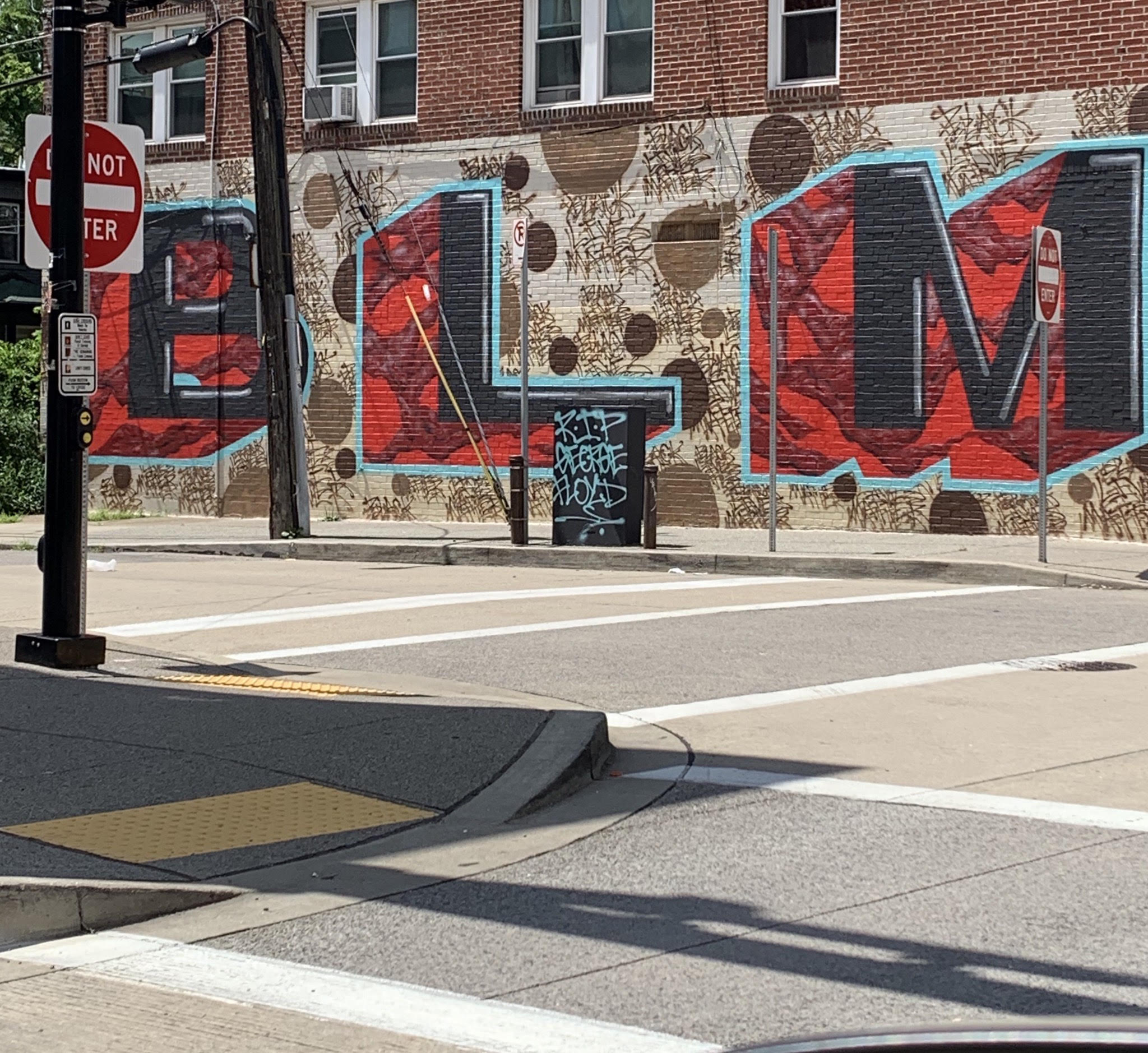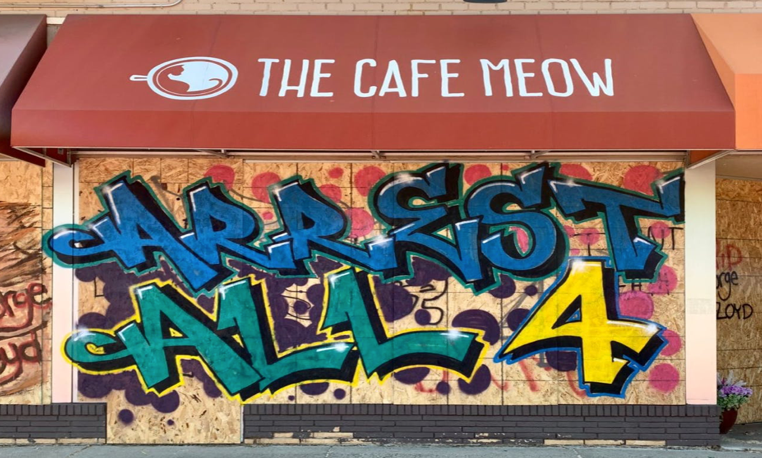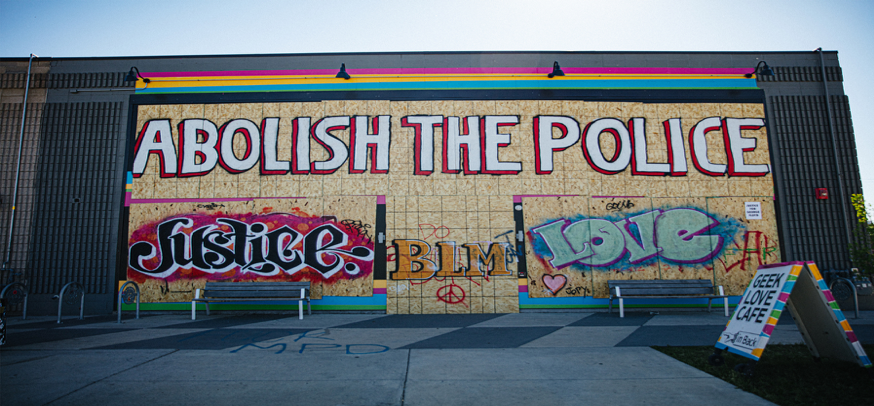When Minneapolis Police Department’s Third Precinct went up in flames, it signaled the transformation of a protest into an uprising that would spread like wildfire throughout the nation. From Minneapolis to Los Angeles, Atlanta, New York City, and more, a large-scale rebellion bloomed from the cracks in the concrete. This scene is indicative of a cultural moment in which iconoclastic fervor has reached its boiling point, leading to the toppling of monuments across the country in the wake of the anti-Black police murders of George Floyd and Breonna Taylor. In fact, we might consider Minneapolis’ Third Precinct itself to be a monument symbolizing the power and authority of police officers. In addition, statues honoring the Confederacy, Christopher Columbus, and other historically racist figures and institutions have faced renewed calls for removal, have been vandalized, or have been toppled by protesters.

Monuments are “statements of power and presence in public” that produce vivid iconographic accounts of who belongs in the United States, and what moments or persons in our history are canonized by the nation. Thus, the toppling of these monuments reflects a desire to challenge the values that undergird this nation. At the same time, we seem to have entered a new phase of political propaganda where Black Lives Matter (BLM) serves as its own monument in the mythological narrative of American racial progress. For example on June 5th, 2020, an official mural was commissioned by Washington D.C. mayor Muriel Bowser. City governments across the country began using these murals as a way to show support for BLM despite the fact that BLM’s D.C. chapter argued that Mayor Bowser’s action was only done to appease white liberals while ignoring the demands of Black organizers. As I’ve previously argued, the Black feminist and abolitionist roots of Black Lives Matter have gradually become white-washed in an effort to produce a mythic narrative of progress. Over time, even the rhetoric of BLM activists have sidelined the focus on the abolition of the police and the United States, instead ratcheting down to a focus on “police brutality” and repealing discriminatory policies. In this way, anti-Blackness is reduced down to an issue of contingent acts of discrimination and faulty elements of an otherwise democratic society rather than understanding anti-Blackness as fundamental to the foundation of the country. As demonstrated by BLM’s #WhatMatters2020 website page dedicated to increasing voter turnout, Black people begin working to become recognized as an equal part of the American project instead of recognizing that the entire project should be abandoned.
Drawing on this broad and capacious understanding of monuments, I want to briefly consider what it might mean to think about Black Lives Matter as a multi-modal monument in and of itself. I argue that the protests, chants, performance, murals, and photography emerging from the Black Lives Matter movement constitute a form of political expression that fits the broad definition of monuments as statements of power and presence in public. I want to examine how these forms of political expression actually highlight the conflict driving political messages that are garnering support amongst Black Lives Matter activists. In particular, I argue that these conflicts emerge over whether the goal of the Black Lives Matter movement is to reform or to abolish the prison industrial complex. Is the goal to reform policing practices and carceral institutions? Should the goal be to make Black Lives Matter within the United States? Or, as Dylan Rodriguez and Angela Davis have argued, is it our duty to unsettle the very idea of policing, carcerality, to shake the foundations of the United States by gesturing toward the possibility of something different? What are the potential consequences of the conversion of Black Lives Matter from an iconoclastic movement into an icon of its own?

Beyond the commissioned murals on Black Lives Matter, even non-commissioned and community-produced murals and protest chants created by Black Lives Matter artists and activists might reflect this tension between reform and abolition. For example, A mural in Minneapolis that reads "Arrest All 4" has become an often-used protest chant in the wake of these murders, referring specifically to the officers involved in killing George Floyd. Another mural in Minneapolis that emerged in the wake of these protests that reads “Abolish the Police", “Justice” “BLM” and “Love” over a boarded-up café demonstrates that there is an abolitionist strain of thought amongst some protesters. Rather than demand that particular officers be arrested, this mural contains a political message that situates the law and the police as mechanisms of a violent regime. Despite the fact that the two murals in question contain conflicting messages, it is commonplace for both of these slogans – “Arrest All 4” and “Abolish the Police” – to be chanted at the same protest by the same people. This reflects that the push-and-pull of reformist and abolitionist rhetoric produce both fights between activists and internal conflicts for individual activists who are wrestling with their own notion of what it means to achieve justice.
Is the answer to this problem to arrest these four officers and those who murdered Breonna Taylor and Tony McDade? Is that how we should measure justice? The abolition of the police and prisons is antagonistic to a demand that we rely on those very institutions to make ethical determinations. If, as Paul Anthony Farley argues, the police are an extension of slave patrols and a system of white-over-black, then arresting the officer involved ratchets down the conversation from the unethicality of the police to a conversation about acts of brutality committed by certain police officers. In this way, Farley explains that we bow down to the law of the slave master of our own volition resulting in the perfection of slavery. Elsewhere I’ve explored how this results also in narratives concerning what it means to be an “authentic” non-violent Black organizer that demonizes protesters more invested in abolition than reform. In this particular instance, the demand for arresting all four officers who partook in the murder of George Floyd might dangerously reproduce what Mariame Kaba has described as a carceral feminism that places Black women at the mercy of the very law enforcement officials who perpetuate gratuitous violence against them and their loved ones.

As thinkers, organizers, and artists interested in Black liberation, how do we wrestle with, and adapt to, the conversion of Black Lives Matter itself into a monument to American racial progress? Examining the differences in the street art emerging out of these protests might contribute to theoretical conversations concerning the role of aesthetics in an abolitionist praxis. Paying attention to what is produced on the ground can help highlight the process by which corporations pick-and-choose which messages to amplify and which messages to suppress. What messages are more readily available for co-option and what messages are harder to incorporate into a narrative that redirects the energy of the people toward a reformation, rather than upheaval, of the status quo? Is the statement that Black Lives Matter itself a domesticated version of the demand for Black power?
